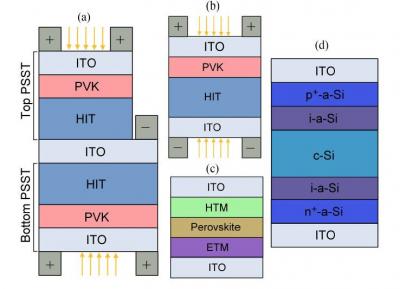Researchers from Lahore University and Benha University have proposed an interesting configuration of combination of solar materials that can possibly boost total electricity output by 10-30% ' reportedly reaching between 30-36% efficiency.
 (a)bifacial per/Si double-tandem cell (b)standalone bifacial single-tandem cell (c)PVK cell (d)Si heterojunction with intrinsic thin layer solar cell
(a)bifacial per/Si double-tandem cell (b)standalone bifacial single-tandem cell (c)PVK cell (d)Si heterojunction with intrinsic thin layer solar cell
The researchers describe the cell: "a 3-T, four-junction perovskite/silicon double-tandem (PSDT) solar cell structure that can efficiently harvest light in all ranges of albedo by stacking two tandem perovskite/silicon cells in a flipped configuration with a common (middle) terminal".
As the solar panel moves above an albedo of 30% ' equivalent of light sand ' and moves toward that of a white rubber EPDM roof, which has an albedo well above 40%, the solar cell becomes saturated with photons and maxes out. Further refinement ' such as varying the thickness of cells ' allows continued gains in efficiency on the backside of the solar cell driving the whole solar panel toward 36% efficiency.
Each layer is chosen to complement the bandgap of the other layers, which maximizes absorption of high and low-energy photons as they move through the solar cell. The layers of perovskite and silicon are reversed on the bifacial side to capture the reflected light.
It should be noted that the 'silicon' layer is actually a heterojunction crystalline silicon-amorphous silicon layer. So the researchers have added two layers of additional material atop a crystalline silicon solar cell.
One reason innovation is following along the crystalline silicon solar cell pathway is that manufacturers have invested significant expertise and money in building over 100 GW/year of factory capacity ' they've got a bit of a case of technology lock in. If an extra machine of two can be added to current lines, much like PERC solar cells did, and we can gain significant efficiencies, then a logical and safe path forward could be migrated towards en masse. Adding a second technique ' bifacial ' just follows along what we're already doing, and lets us take advantage of single axis trackers which are already learning to maximize bifacial technology.